Related Research Articles

Kabbalah is an esoteric method, discipline, and school of thought in Jewish mysticism. A traditional Kabbalist in Judaism is called a Mequbbāl. The definition of Kabbalah varies according to the tradition and aims of those following it, from its religious origin as an integral part of Judaism, to its later adaptations in Western esotericism. Jewish Kabbalah is a set of esoteric teachings meant to explain the relationship between the unchanging, eternal God—the mysterious Ein Sof —and the mortal, finite universe. It forms the foundation of mystical religious interpretations within Judaism.
The occult, in the broadest sense, is a category of supernatural beliefs and practices which generally fall outside the scope of religion and science, encompassing such phenomena involving otherworldly agency as mysticism, spirituality, and magic. It can also refer to supernatural ideas like extra-sensory perception and parapsychology.

A philosopher is someone who practices philosophy. The term philosopher comes from the Ancient Greek: φιλόσοφος, romanized: philosophos, meaning 'lover of wisdom'. The coining of the term has been attributed to the Greek thinker Pythagoras.

Rudolf Joseph Lorenz Steiner was an Austrian philosopher, social reformer, architect, esotericist, and claimed clairvoyant. Steiner gained initial recognition at the end of the nineteenth century as a literary critic and published philosophical works including The Philosophy of Freedom. At the beginning of the twentieth century he founded an esoteric spiritual movement, anthroposophy, with roots in German idealist philosophy and theosophy; other influences include Goethean science and Rosicrucianism.

Christian theosophy, also known as Boehmian theosophy and theosophy, refers to a range of positions within Christianity which focus on the attainment of direct, unmediated knowledge of the nature of divinity and the origin and purpose of the universe. They have been characterized as mystical philosophies. Theosophy is considered part of Western esotericism, which believes that hidden knowledge or wisdom from the ancient past offers a path to enlightenment and salvation.
Theurgy describes the practice of rituals, sometimes seen as magical in nature, performed with the intention of invoking the action or evoking the presence of one or more deities, especially with the goal of achieving henosis and perfecting oneself.

Rosicrucianism is a spiritual and cultural movement that arose in Europe in the early 17th century after the publication of several texts that purported to announce the existence of a hitherto unknown esoteric order to the world and made seeking its knowledge attractive to many. The mysterious doctrine of the order is "built on esoteric truths of the ancient past", which "concealed from the average man, provide insight into nature, the physical universe, and the spiritual realm." The manifestos do not elaborate extensively on the matter, but clearly combine references to Kabbalah, Hermeticism, alchemy, and Christian mysticism.

A catechism is a summary or exposition of doctrine and serves as a learning introduction to the Sacraments traditionally used in catechesis, or Christian religious teaching of children and adult converts. Catechisms are doctrinal manuals – often in the form of questions followed by answers to be memorised – a format that has been used in non-religious or secular contexts as well. According to Norman DeWitt, the early Christians appropriated this practice from the Epicureans, a school whose founder Epicurus had instructed to keep summaries of the teachings for easy learning. The term catechumen refers to the designated recipient of the catechetical work or instruction. In the Catholic Church, catechumens are those who are preparing to receive the Sacrament of Baptism. Traditionally, they would be placed separately during Holy Mass from those who had been baptized, and would be dismissed from the liturgical assembly before the Profession of Faith and General Intercessions.
Knowledge is a term used by Shri Hans Ji Maharaj to denote a formulation of four specific techniques that were imparted in a process of initiation. The term continues to be used by two of Shri Hans Ji Maharaj's sons, Satpal Rawat and Prem Rawat.

Alice Ann Bailey was a writer of more than twenty-four books on theosophical subjects, and was one of the first writers to use the term New Age. Bailey was born as Alice La Trobe-Bateman, in Manchester, England. She moved to the United States in 1907, where she spent most of her life as a writer and teacher.

New Acropolis is a non-profit organisation originally founded in 1957 by Jorge Ángel Livraga Rizzi in Argentina, positioning itself as a school of philosophy, although various researchers characterize it as an esoteric and post-theosophical new religious movement, or sometimes as a cult. As of 2010, it claimed branches in more than forty countries. As of 2020, its president is Carlos Adelantado Puchal.

Western esotericism, also known as esotericism, esoterism, and sometimes the Western mystery tradition, is a term scholars use to categorise a wide range of loosely related ideas and movements that developed within Western society. These ideas and currents are united by the fact that they are largely distinct both from orthodox Judeo-Christian religion and Enlightenment rationalism. Esotericism has pervaded various forms of Western philosophy, religion, pseudoscience, art, literature, and music—and continues to influence intellectual ideas and popular culture.

A Course in Miracles is a 1976 book by Helen Schucman. The underlying premise is that the greatest "miracle" is the act of simply gaining a full "awareness of love's presence" in one's own life. Schucman claimed that the book had been dictated to her, word for word, via "inner dictation" from Christ. The book is considered to have borrowed from various New Age movement literature.
The General Anthroposophical Society is an "association of people whose will it is to nurture the life of the soul, both in the individual and in human society, on the basis of a true knowledge of the spiritual world." As an organization, it is dedicated to supporting the community of those interested in the inner path of schooling known as anthroposophy, developed by Rudolf Steiner.

Obscurantism and Obscurationism describe the practice of deliberately presenting information in an imprecise, abstruse manner designed to limit further inquiry and understanding. There are two historical and intellectual denotations of Obscurantism: (1) the deliberate restriction of knowledge—opposition to disseminating knowledge; and (2) deliberate obscurity—a recondite literary or artistic style, characterized by deliberate vagueness.

Hylozoism is the philosophical point of view that matter is in some sense alive. The concept dates back at least as far as the Milesian school of pre-Socratic philosophers. The term was coined by the English philosopher Ralph Cudworth in 1678.

Esoteric interpretation of the Quran is the allegorical interpretation of the Quran or the quest for its hidden, inner meanings. The Arabic word taʾwīl was synonymous with conventional interpretation in its earliest use, but it came to mean a process of discerning its most fundamental understandings. Esoteric interpretations do not usually contradict the conventional interpretations; instead, they discuss the inner levels of meaning of the Quran.

Theosophical teachings have borrowed some concepts and terms from Buddhism. Some theosophists like Helena Blavatsky, Helena Roerich and Henry Steel Olcott also became Buddhists. Henry Steel Olcott helped shape the design of the Buddhist flag. Tibetan Buddhism was popularised in the West at first mainly by Theosophists including Evans-Wentz and Alexandra David-Neel.
Sergei Olegovich Prokofieff was a Russian anthroposophist. He was the grandson of the composer Sergei Prokofiev and his first wife Lina Prokofiev, and the son of Oleg Prokofiev and his first wife Sofia Korovina. Born in Moscow, he studied fine arts and painting at the Moscow School of Art. He encountered anthroposophy in his youth, and soon made the decision to devote his life to it.

The Initiative for Open Citations (I4OC) is a project launched publicly in April 2017, that describes itself as: "a collaboration between scholarly publishers, researchers, and other interested parties to promote the unrestricted availability of scholarly citation data and to make these data available." It is intended to facilitate improved citation analysis.
References
- ↑ "Introduction to the Works of Henry T. Laurency". The Official Website of the Henry T. Laurency Publishing Foundation. Retrieved 4 January 2016.
- ↑ "Introduction to the Works of Henry T. Laurency". The Official Website of the Henry T. Laurency Publishing Foundation. Retrieved 7 January 2016.